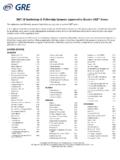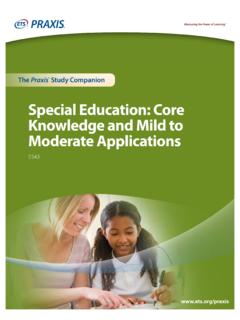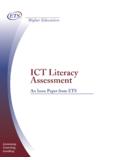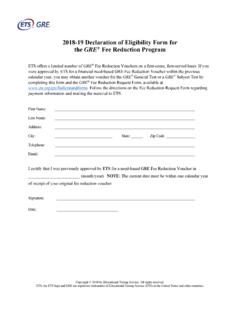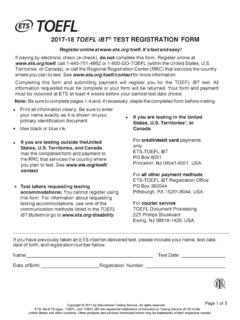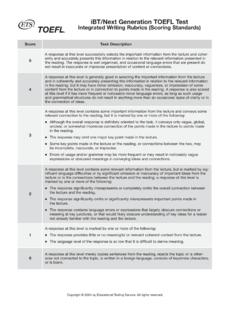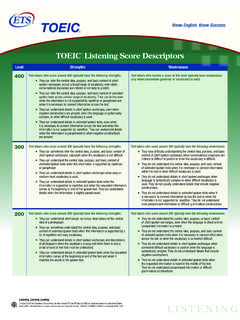Transcription of English to Speakers of Other Languages study companion
1 English to Speakers of Other Languages Praxis study CompanionThe Praxis study Companion2 Welcome to the Praxis study CompanionWelcome to The Praxis study companion Prepare to Show What You KnowYou have been working to acquire the knowledge and skills you need for your teaching career. Now you are ready to demonstrate your abilities by taking a Praxis test. Using the Praxis study companion is a smart way to prepare for the test so you can do your best on test day. This guide can help keep you on track and make the most efficient use of your study study companion contains practical information and helpful tools, including: An overview of the Praxis tests Specific information on the Praxis test you are taking A template study plan study topics Practice questions and explanations of correct answers Test-taking tips and strategies Frequently asked questions Links to more detailed informationSo where should you start?
2 Begin by reviewing this guide in its entirety and note those sections that you need to revisit. Then you can create your own personalized study plan and schedule based on your individual needs and how much time you have before test in mind that study habits are individual. There are many different ways to successfully prepare for your test. Some people study better on their own, while others prefer a group dynamic. You may have more energy early in the day, but another test taker may concentrate better in the evening. So use this guide to develop the approach that works best for teaching career begins with preparation. Good luck!Know What to ExpectWhich tests should I take? Each state or agency that uses the Praxis tests sets its own requirements for which test or tests you must take for the teaching area you wish to you register for a test, confirm your state or agency s testing requirements at are the Praxis tests given?
3 Praxis tests are given on computer. Other formats are available for test takers approved for accommodations (see page 44).The Praxis study Companion3 Welcome to the Praxis study CompanionWhat should I expect when taking the test on computer?When taking the test on computer, you can expect to be asked to provide proper identification at the test center. Once admitted, you will be given the opportunity to learn how the computer interface works (how to answer questions, how to skip questions, how to go back to questions you skipped, etc.) before the testing time begins. Watch the What to Expect on Test Day video to see what the experience is and when are the Praxis tests offered?You can select the test center that is most convenient for you. The Praxis tests are administered through an international network of test centers, which includes Prometric Testing Centers, some universities, and Other locations throughout the schedules may differ, so see the Praxis web site for more detailed test registration information at The Praxis study Companion4 Table of ContentsTable of ContentsThe Praxis study companion guides you through the steps to success1.
4 Learn About Your Test ..5 Learn about the specific test you will be taking2. Familiarize Yourself with Test Questions ..9 Become comfortable with the types of questions you ll find on the Praxis tests3. Practice with Sample Test Questions ..13 Answer practice questions and find explanations for correct answers4. Determine Your Strategy for Success ..22 Set clear goals and deadlines so your test preparation is focused and efficient5. Develop Your study Plan ..25 Develop a personalized study plan and schedule6. Review study Topics ..29 Review study topics with questions for discussion7. Review Smart Tips for Success ..42 Follow test-taking tips developed by experts8. Check on Testing Accommodations ..44 See if you qualify for accommodations to take the Praxis test9. Do Your Best on Test Day ..45 Get ready for test day so you will be calm and confident10. Understand Your Scores ..47 Understand how tests are scored and how to interpret your test scoresAppendix: Other Questions You May Have.
5 49 The Praxis study Companion5 Step 1: Learn About Your Test1. Learn About Your TestLearn about the specific test you will be takingEnglish to Speakers of Other Languages (5362)Test at a GlanceTest Name English to Speakers of Other LanguagesTest Code 5362 Time 120 minutesNumber of Questions 120 selected-response questionsFormat Selected-response questionsTest Delivery Computer delivered Approximate Approximate Content Categories Number of Percentage of Questions Examination I. Foundations of Linguistics 22 18% II. Foundations of Language Learning 26 22% III. Planning and Implementing Instruction 28 23% IV. Assessment and Evaluation 18 15% V. Culture 13 11% VI. Professionalism and Advocacy 13 11%VIVIVIIIIIIA bout This TestThe English to Speakers of Other Languages (ESOL) test is designed to measure basic linguistic and pedagogical knowledge for those interested in working in the context of teaching ESOL in elementary or secondary schools.
6 Candidates usually come from a variety of backgrounds. Some are preservice teachers who are recent graduates of an ESOL degree program, some may be experienced ESOL teachers moving from a different state, while others are current teachers who have changed from their content area of education to ESOL. The Praxis ESOL test is categorized into six content categories of expertise, as shown in the pie chart above. Candidates are expected to demonstrate the knowledge and skills required of a beginner-level K-12 ESOL teacher. The six content categories were identified, via rigorous content analyses, by nationally recognized thought leaders in the field of TESOL and applied linguistics. Having basic knowledge in each category was deemed critical for the beginning-level ESOL works in collaboration with teacher educators, higher-education content specialists, and accomplished teachers to keep the test updated and representative of current and relevant has aligned the questions on this test with the Standards for the Recognition of Initial TESOL Programs in P-12 ESL Teacher Education, developed by TESOL international Association and the Council for the Accreditation of Educator Preparation (CAEP).
7 Test takers have two hours to complete 120 multiple-choice questions, which have listening questions embedded throughout the test. For the listening questions, test takers have an opportunity to listen to a recorded prompt multiple times, taking into account time considerations. Some of the questions ask candidates The Praxis study Companion6 Step 1: Learn About Your Testto choose more than one answer, which helps to capture the breadth of a candidate s knowledge. This test may contain some questions that will not count toward the test taker s total score. Test SpecificationsTest specifications in this chapter describe the knowledge and skills measured by the test. study topics to help you prepare to answer test questions can be found on page Foundations of LinguisticsA. Understands phonetics , stress and intonation patterns, and the effects of phonetic environment on pronunciationB. Is familiar with IPA (the international Phonetic alphabet )C.
8 Understands the various types of morphemes and how they are used in word formationD. Understands the usage of English syntaxE. Understands the parts of speech including their structural, semantic, and functional characteristics F. Understands semantics and how combinations of words convey meaningG. Knows that Languages differ from or are similar to each Other in their phonology, morphology, syntax, semantics, and pragmatics H. Understands the concepts of pragmaticsI. Understands the concepts of sociolinguistics J. Knows the concept of World Englishes K. Understands the conventions of written English ( , mechanics) L. Understands the rhetorical patterns and range of genres used in written English M. Understands communicative competence N. Know about the inconsistencies and irregularities of the English language II. Foundations of Language LearningA. Understands the distinction between social and academic language functions B.
9 Understands the similarities and differences between first and second language acquisition, and how learners first language can affect their second-language production and reception C. Understands the processes of second-language acquisition including research-based modelsD. Knows the different types of affective factors and their implications for the second-language learning process E. Understands the relationship between English phonemes and graphemes and the rules of phonics F. Understands the literacy development of ELs G. Understands how first-language literacy influences the development of English literacy H. Understands that, in addition to language, student performance may be affected by various factors ( , socioeconomic, physical, emotional) III. Planning and Implementing InstructionA. Knows the implication of dialect variation for the instruction of English learners B. Understands various methods and approaches in teaching ELs and knows how to select the most appropriate methods for the context C.
10 Knows a variety of instructional delivery models specific for ELs D. Knows how to identify appropriate and measureable objectives that align to language and content standards E. Knows how to design appropriate classroom activities that connect to learning objectives for ELs F. Knows how to design appropriate assessments that connect to learning objectives for ELs G. Is familiar with ways to collaborate with Other educators in designing classroom activities appropriate to the proficiency levels of English learnersH. Knows how to effectively integrate the four domains of language ( , speaking, listening, reading, and writing) into instruction I. Knows how to promote ELs acquisition of receptive and productive skillsJ. Knows how and when to apply a variety of The Praxis study Companion7 Step 1: Learn About Your Teststrategies for teaching language skills contextually or targeting them discretely K.
